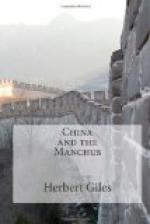No record of this Emperor, however brief, could fail to notice the literary side of his character, and his extraordinary achievements in this direction. It is almost paradoxical, though absolutely true, that two Manchu Emperors, sprung from a race which but a few decades before had little thought for anything beyond war and the chase, and which had not even a written language of its own, should have conferred more benefits upon the student of literature than all the rest of China’s Emperors put together. The literature in question is, of course, Chinese literature. Manchu was the court language, spoken as well as written, for many years after 1644, and down to quite recent times all official documents were in duplicate, one copy in Chinese and one in Manchu; but a Manchu literature can hardly be said to exist, beyond translations of all the most important Chinese works. The Manchu dynasty is an admirable illustration of the old story: conquerors taken captive by the conquered.
At this moment, the term “K`ang Tsi” is daily on the lips of every student of the Chinese language, native or foreign, throughout the empire. This is due to the fact that the Emperor caused to be produced under his own personal superintendence, on a more extensive scale and a more systematic plan than any previous work of the kind, a lexicon of the Chinese language, containing over forty thousand characters, with numerous illustrative phrases chronologically arranged, the spelling of each character according to the method introduced by Buddhist teachers and first used in the third century, the tones, various readings, etc., etc., altogether a great work and still without a rival at the present day.
It would be tedious even to enumerate all the various literary undertakings conceived and carried out under the direction of K`ang Hsi; but there are two works in particular which cannot be passed over. One of these is the huge illustrated encyclopaedia in which everything which has ever been said upon each of a vast array of subjects is brought into a systematized book of reference, running to many hundred volumes, and being almost a complete library in itself. It was printed, after the death of K`ang Hsi, from movable copper types. The other is, if anything, a still more extraordinary though not such a voluminous work. It is a concordance to all literature; not of words, but of phrases. A student meeting with an unfamiliar combination of characters can turn to its pages and find every passage given, in sufficient fullness, where the phrase in question has been used by poet, historian, or essayist.




